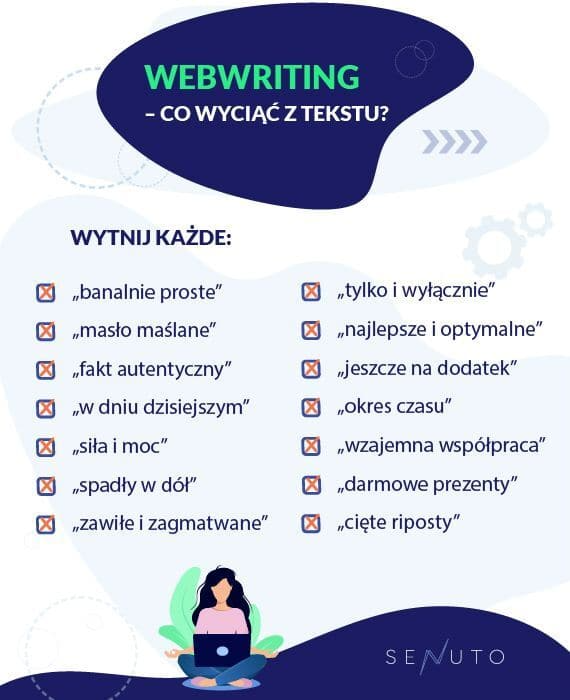10 seconds – that’s how much time you give me to convince you that it’s worth reading this text further. 10 minutes – that’s how long you have to spend to get to the end of this article. 10 rules – in this many points I have included answers to questions about webwriting:
- How to attract the reader’s attention?
- How to build a text?
- What characteristics should a good text published on the Internet have?
- How long should the text be ?
- How tricks to use to efficiently shorten the text?
- How to keep the attention of the Internet user?
- How to write texts for the Internet?
- How to create a good title?
.
.
.
.
.
.
.
To begin with, I’ll let you in on a secret: knowing the rules of writing print articles, is not enough to write for the Internet. Why?
1. Articles on the Internet are not read by anyone
.
The average Internet user doesn’t read the content of pages or articles – only browses through them. Only 16% of web users read the text word by word, and even so, most of us do it quickly, impatiently and inattentively. Studies show that we are less engaged in monitor and screen reading than in reading a paper newspaper or book. This is one reason why we are less likely to understand and remember texts given to us in electronic form. Instead, we are quicker to take a certain stance towards them and evaluate them.
Internauts decide within 10 seconds whether they want to continue reading the text or prefer to move on to the next one. This means that you have about 220 words to convince a virtual reader that your article is worth spending time on.
The way Internet users consume content posted on the Web has forced the emergence of new rules for preparing text for the Web. Webwriting draws from Internet psychology, marketing, traditional journalism and even computer science, but the foundation here is still knowledge of correct Polish (or any other language you want to write in).
Read also: What to blog about? 9 topic sources and 34 article ideas.
2. Do you know who you are writing for? Know your persona
.
Do you know the marketing concept of target audience or target? A persona is to a webwriter what a target is to a marketer. Every piece of content you create should address a specific audience. Before you start writing, ask yourself – who are you writing for Create 4 – 6 profiles of people who might want to read your text.
Imagine the person sitting on the other side of the screen. Answer the questions: how old is he/she? What gender is she? What is her family status? What education does she have? Where does she live? Where does she work? In what position? How much does she earn? For what purpose does she read the text? What are her needs? What tasks does she want to accomplish with the article? Give her a name, create a story and a psychological profile..
Creating a persona is the first point in both the work of a web designer, marketer and webwriter. Therefore, if you have the opportunity – use their experience, it will make your work much easier.
 .
.
This text is read by Alicia, she is twenty-two – twenty-three years old. She is just about to graduate with a degree in Polish studies or journalism. She is looking for a way to gain work experience and at the same time wants to make some money for herself. She found a job offer at a marketing agency, but they require knowledge of the basics of webwriting. She typed the phrase “basic principles of webwriting” into Google and that’s how she came across this article.
What is a webwriter’s persona used for? .
The language you use in your texts should be tailored to the reader. Descriptions of a new clothing collection for young people will sound different, and business advice will sound different.
When writing to young people, you can adopt informal, even colloquial language. Write something like: “a green hoodie will refresh your spring look, it looks great with slims. Your classmates at school will envy you”.
On the other hand, when creating a business text, use literary language, and when addressing customers – the polite form “Mr. and Mrs.”. A business text might sound like this: “The higher fuel surcharge rate introduced by the government may affect price increases at gas stations.”
3 Highlights to start with
.
The inverted pyramid rule is not any innovative solution proposed by webwriting. It’s an old journalistic rule, which says that the text should be built according to the scheme: put the most important information at the beginning, allocate subsequent paragraphs to detail it, and you can introduce side plots at the end.
Internet users pay most attention to the top of the text. Which means that the higher up a paragraph is, the more important it is to the reader. For this reason, it is in the first sentences that you should include the most important information.
Wypróbuj Senuto Suite przez 14 dni za darmo
Zacznij 14-dniowy trial za darmo4. Specific, concise, simple and to the point
.
The online reader is impatient, expects specific information available in the shortest possible time. When creating texts, try to write rhetorically, concisely and substantively, without “pouring water”, unnecessary embellishments and deviating from the topic. Build simple sentences and use understandable language.
If you are describing a new drill, your reader will be a professional builder who demands specifics about the parameters and functioning of the device. The phrase, “the de facto drill is one of the critical power tools in the workshop,” is convoluted, vague and incomprehensible. You will only annoy the customer, who will order the drill from a competitor.
How long should the text for the Internet be? It depends on the type of text. However, it should not be less than 500 characters – shorter texts are treated by Google’s robots as of little value, which affects the position of the page on which they appear. Studies show that the optimal length is 2,000 – 4,000 characters. Websites with texts of this length record a much lower rejection rate, and the time users stay on the site increases.
5. “The power and force of a cutting retort”, or how to cut text in half
After writing a text, put it aside for a while – preferably for a few days – then come back to it and read it again. Is everything understandable to you? The text reads smoothly? You have included all the most important information? Great, in view of this time to cut!
Jacob Nielsen, a web usability specialist, says that text should be shortened by 50% after writing! In practice – without harm to the content and pain for the author, you can cut 15 – 25% of the text.
How to shorten the text? First, throw out from your article all unnecessary embellishments that contribute nothing to the content. Remove fillers, such as: “naturally”, “generally”, “almost”, “really”, etc. Each of us has our own linguistic favorites that we often overuse. After all, “however,” because” and “of course” fit into every sentence!
Then check for pleonasms and tautologies in the text, cut out each: “trivially simple” “buttercream” that “authentic fact” in “today’s day” made the “strength and power” of your text “fall down” and the information became “convoluted and confusing”. Your article should include “only” the “best and optimal” phrases, and “still in addition” remove: “time periods”, “mutual cooperation”, “free gifts” and “cutting retorts”.

6. text clarity and readability
You have succeeded! You managed to convince the Internet user to read your text. Now you face another challenge – you need to keep his attention.
Internet users read inaccurately and impatiently, they scan the text and search for information rather than read every word. Make it easy for them to search: use headings and mid-headings that indicate the content of paragraphs. Highlight the most important words and information – make them bold, italic, color or VERSIONS.
Jacob Nielsen, based on eye-tracking studies, came to the conclusion that readers’ attention on the Internet takes the shape of the letter “F”. This means that Internet users read the first few sentences from beginning to end. Later, keeping to the left margin, they run their eyes down the text. In the middle of the article, they stop to read more carefully the left part of the next few sentences and scan downward again.
What is the conclusion for the webwriter? Align text published on the web to the left. Take care, as much as possible, that the words and information you want to draw the reader’s attention to are displayed at the left margin.
Have you noticed? None of the paragraphs in this text is more than 6 lines long. This is a deliberate effort to avoid scaring you with a wall of text. Internet users are more likely to read texts divided into captions of 4 – 6 lines each. Longer blocks create discouragement and may make the reader abandon the article.
7. text on the Internet must be dynamic and simple
In virtual reality, everything happens fast. With one click you buy new furniture, in a few seconds you get in touch with someone on the other side of the globe, you immediately get an answer to your question from a search engine. The Internet is dynamic, and so should be the texts made available on it..
You will achieve dynamism by using simple sentences. Avoid elaborate, repeatedly complex constructions. Use verbs in the active side: “go”, “run”, “did”. Forget the passive side and verbose nouns, e.g., “made”, “said”, “did”, “defaulted”, “rested”, “did”.
8. converse
High conversion is the dream of every marketing professional. A webwriter’s job is to make it a reality. Your texts should be converting. What does that mean? The article should encourage interaction. This can be: leaving a comment, entering into a discussion, clicking “Like,” making a purchase, or giving an opinion on a product.
You will achieve conversationality by using verbs in the active side. Shorten the distance by using the “you” form. Remember, however, that not everyone can or should be written to informally. There are some industries and clients who will feel offended by such a tone of text, so always adapt your language to your persona.
Find key phrases that will translate traffic into sales!
.
9. title and lead
The title and the introduction to the text (lead) are, not coincidentally, at the end of this article. These two elements are best created after you write the text. The introduction is meant to be a kind of summary, so creating it before the entire article can be tricky. It’s based on the headline and lead that users decide if they want to wade further into your article. Therefore, when coming up with a title, treat it like an advertising slogan.
10 SEO principles
The texts you write for company websites, portals or blogs are not only supposed to be eagerly read by users, but also raise the page’s position in search results. Therefore, before you start writing, familiarize yourself with the rules for creating SEO texts.
If you want to become a webwriter, you need to remember that, like the Internet as a whole, this is a dynamic field. New research is constantly being published, SEO guidelines are changing and user behavior on the web is changing. If you want to be good at what you do, you need to keep up to date with trends and adapt the texts you create to them.
If you want to learn SEO, take a peek at this list – Karolina has collected free SEO courses in one place.
.
 Katarzyna Adamczak
Katarzyna Adamczak